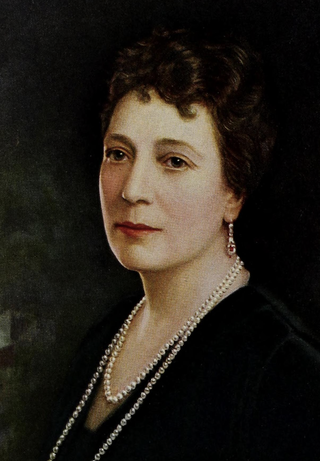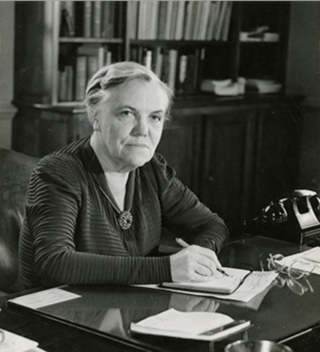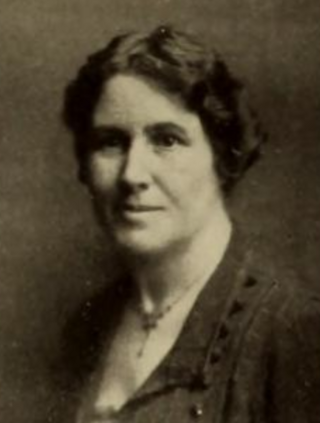Marion Coats Graves (August 2, 1885 - November 19, 1962) was an American educator known for her work in creating two-year junior colleges for women. [1] She helped establish and was the first president of Sarah Lawrence College. [2]
Marion Coats Graves (August 2, 1885 - November 19, 1962) was an American educator known for her work in creating two-year junior colleges for women. [1] She helped establish and was the first president of Sarah Lawrence College. [2]
Marion Coats was born in Eaton, New York on August 2, 1885. [3] Her parents were Albert B. Coats and Dilla Marie Woodworth Coats. She graduated from Oak Place Private School in Akron, Ohio in 1903. [3] She graduated from Vassar College with an A.B. in 1907. [3] Her graduate work was done at Yale University (1910-1911) and then at Radcliffe College between then and 1915. [3] She achieved an M.A. and Ph.D in philosophy. [3] She also did additional post-graduate work at Teachers College, Columbia University between 1930 and 1932. [3]
She began her teaching career immediately after graduating Vassar, teaching at various schools including Kimball's School in Worcester, Massachusetts, the Oxford School in Hartford, Connecticut and Miss McClintock's School in Boston. [3] She taught subjects including math, Latin, English and athletics. [3] In 1915 she became principal of Ferry Hall School in Lake Forest, Illinois. [3] She was president of the National Association of Principals of Schools for Girls from 1920 to 1923. [3]
She was the head of Bradford Academy [4] in Bradford, Massachusetts from 1918 to 1927, [1] which she helped transition into a junior college. [3] It was her work at Bradford that brought her to the attention of Henry Noble MacCracken, who was assisting William Lawrence in his effort to endow a new college. [2] She and MacCracken incorporated the ideas she developed at Bradford into the founding of Sarah Lawrence College. It became the first chartered junior college in New York state and she was its first president. [1] [5] It was one of the first two-year junior colleges in the country. [6] She was president from 1926 to 1929, [7] but ultimately resigned her position after she and MacCracken had disagreements over policy. [2]
In 1932 she became acting president of Westbrook Seminary in Portland, Maine. [1] She then served as dean of Ogontz Junior College in Rydal, Pennsylvania for nine years. [1] She later returned to Bradford Junior College as its dean in 1950-1951 before retiring. [8]
She married Clifford L. Graves of Hartford in July 1929. [3] Her husband died before her, and she died in Boston on November 19, 1962. [1]

Sarah Lawrence College is a private liberal arts college in Yonkers, New York. Originally a women's college, Sarah Lawrence became coeducational in 1968.

Maria Mitchell was an American astronomer, librarian, naturalist, and educator. In 1847, she discovered a comet named 1847 VI that was later known as "Miss Mitchell's Comet" in her honor. She won a gold medal prize for her discovery, which was presented to her by King Christian VIII of Denmark in 1848. Mitchell was the first internationally known woman to work as both a professional astronomer and a professor of astronomy after accepting a position at Vassar College in 1865. She was also the first woman elected Fellow of the American Academy of Arts and Sciences and the American Association for the Advancement of Science.

Bradford College was a college in the part of Haverhill, Massachusetts, that was once the town of Bradford. Founded in 1803, Bradford College began as Bradford Academy, one of the earliest coeducational institutions in New England. In 1836, Bradford began educating women exclusively. By 1932, the school had grown from a secondary school and became Bradford Junior College. In 1971 Bradford became authorized to grant bachelor's degrees. The new Bradford College began admitting men again that same year. Bradford College specialized in the creative arts and social sciences, and had one of the oldest alum associations in the country.

Euthenics is the study of improvement of human functioning and well-being by improvement of living conditions. "Improvement" is conducted by altering external factors such as education and the controllable environments, including environmentalism, education regarding employment, home economics, sanitation, and housing, as well as the prevention and removal of contagious disease and parasites.
Caroline Farrar Ware (1899–1990) was a professor of history and a New Deal activist. Her work focused on community development, consumer protection, industrial development, civil rights, and women's issues.
Josiah Calvin McCracken was an American football player and track and field athlete.

Henry Mitchell MacCracken was an American educator and academic administrator.

Ruth Isabelle Skinner was an American businesswoman and philanthropist. She was a daughter of silk manufacturer William Skinner (1824–1902) and his second wife, the former Sarah Elizabeth Allen (1834–1908). Belle Skinner was a humanitarian and music-lover whose life her brother William memorialized in the construction of the Skinner Hall of Music at Vassar College in 1932. She lived most of her life at the family home, Wistariahurst, in Holyoke, Massachusetts, now a historic site. She renovated and expanded this house to reflect her interests, including adding the music room, where she housed her musical instrument collection, now housed at Yale University.
Bertha Sheppard Adkins, was an educator, political activist, public servant, and a community leader.
Ruth Maxon Adams (1883–1970) was an American architect.
Charlotte Cynthia Barnum, mathematician and social activist, was the first woman to receive a Ph.D. in mathematics from Yale University.

Katharine Blunt was an American chemist, professor, and nutritionist who specialized in the fields of home economics, food chemistry and nutrition. Most of her research was on nutrition, but she also made improvements to research on calcium and phosphorus metabolism and on the basal metabolism of women and children. She served on the faculty at The University of Chicago and as the third president of Connecticut College for Women.

John Henry MacCracken was an American academic administrator who served as president of Westminster College and Lafayette College. When he was chosen as president of Westminster College in 1899, MacCracken was the youngest college president in the United States. MacCracken was the son of Henry MacCracken, a chancellor of New York University, and the brother of Henry Noble MacCracken, a president of Vassar College.

Henry Noble MacCracken was an American academic administrator who was the fifth president of Vassar College in Poughkeepsie, New York, serving from 1915 to 1946 as the first secular president of the college. MacCracken's term as president of Vassar College is the longest in the college's history.

Grace Harriet Macurdy was an American classicist, and the first American woman to gain a PhD from Columbia University. She taught at Vassar College for 44 years, despite a lengthy conflict with Abby Leach, her first employer.
Ludie Clay Andrews was an American nurse, stated to be a pioneer of nursing.

Dorothy Carolin Bacon was an American economist and college professor. She was an economics professor at Smith College for over thirty years, beginning in 1927, and worked for various federal agencies during her career. She was a Fulbright Scholar in 1956 and 1957, studying credit institutions in the Philippines.
Evelyn Walton Ordway was an American chemist, suffragist and university professor at Newcomb College in New Orleans. She was a chemistry and physics professor at Newcomb College for seven years and was active in the Louisiana women's suffrage movement, becoming the first president of the Louisiana State Suffrage Association.

Frances Fenton Bernard Park was an American college professor and dean. She succeeded Ada Louise Comstock as dean of Smith College, an office she held from 1924 to 1928.